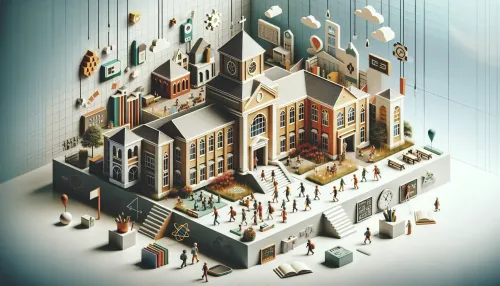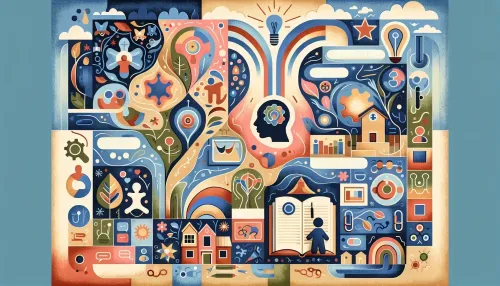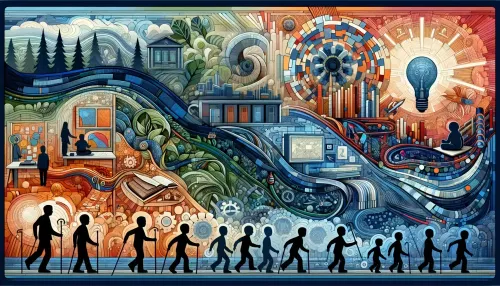From Seclusion to Inclusion: The Evolution of Classroom Strategies for Autistic Students

In recent years, there has been a significant shift in how we approach the education and inclusion of autistic students. From once being secluded from mainstream education, to now being actively encouraged to participate and thrive within inclusive classroom settings, the journey has been remarkable. The "HorizonsMind Blog" delves into this transformative evolution, exploring key strategies and initiatives that have revolutionized the educational landscape for autistic children.
In the past, many autistic students were isolated from their mainstream peers, often placed in separate classrooms or even specialized schools. However, as attitudes towards inclusion have advanced, there has been a gradual shift towards full inclusion in mainstream settings. This movement has been instrumental in creating an environment where all students can learn from each other, embrace differences, and foster an inclusive community within educational institutions.
Revisiting Mainstreaming Strategies for Autistic Students
One of the most impactful changes in accommodating autistic students has been the transition from standardized learning materials to personalized curricula tailored to individual needs. Recognizing that each child learns differently, educators and specialists have championed the development of customized educational plans. These plans not only accommodate diverse learning styles but also capitalize on each student's strengths, providing a more effective and enriching educational experience.
Tailored Curricula for Individual Learning Needs
Central to the paradigm shift in educational practices has been the emphasis on embracing neurodiversity within the classroom. By acknowledging and celebrating diverse learning styles and strengths, educators have created an environment where autistic students feel valued and understood. This approach fosters a culture of respect and appreciation for individual differences, enriching the overall learning experience for all students.
The physical layout of classrooms plays a pivotal role in creating an inclusive environment for autistic students. Traditional classroom configurations often posed challenges for individuals with sensory sensitivities and diverse learning needs. However, with a focus on engagement and accessibility, modern classroom designs now prioritize flexible seating arrangements, sensory-friendly spaces, and designated quiet areas, catering to the specific requirements of autistic students while promoting a more conducive learning environment for everyone.
Fostering Neurodiversity in Educational Settings
Encouraging peer interaction is fundamental in fostering a supportive and inclusive atmosphere within schools. The evolution from limited interaction to active peer support systems has greatly benefited autistic students. Educators are now implementing structured programs that promote understanding, empathy, and collaboration among peers. This not only cultivates meaningful friendships but also fosters a sense of community where every student is integral to the social fabric of the classroom.
Reinventing Classroom Design for Inclusion
Technology has emerged as a valuable ally in enhancing the educational experience for autistic students. From personalized learning apps to assistive communication devices, technology is no longer an overlooked tool but instead a central component of the learning process. Its integration empowers autistic learners by providing alternative means of expression, improving communication skills, and facilitating independent learning.
Empowering Peer Engagement and Support
Equipping educators with specialized training in neurodiversity and inclusive teaching practices is paramount to ensuring the success of autistic students within mainstream classrooms. Teacher training paradigms have shifted towards comprehensive professional development programs that emphasize understanding neurodiverse needs, implementing personalized teaching strategies, and creating an inclusive environment where every student can thrive.
An essential aspect of evolving classroom strategies for autistic students involves amplifying their voices within education policy discussions. Through active advocacy and representation, policies are increasingly being shaped with valuable input from autistic individuals themselves. This inclusive approach ensures that educational frameworks are designed to cater to their unique needs while promoting equity and access to quality education for all.
Utilizing Technology to Enhance Learning
In conclusion, the transformation of classroom strategies for autistic students reflects a profound shift towards inclusivity, personalized learning experiences, and empathetic educational environments. By embracing neurodiversity, advocating for policy inclusivity, empowering educators with specialized skills, and leveraging innovative tools and approaches, we are collectively nurturing an educational landscape where autistic children are not just included but celebrated for their individuality.
Frequently Asked Questions
Key strategies for including autistic students involve embracing neurodiversity, utilizing tailored curricula, and fostering peer engagement. These approaches create an inclusive environment where diverse learning styles are recognized, allowing all students to thrive together while promoting understanding and collaboration among peers.
Classroom design has evolved to support autistic students by prioritizing flexible seating arrangements, sensory-friendly spaces, and designated quiet areas. These modern layouts cater to the specific needs of autistic learners, creating a more engaging and accessible educational environment that benefits all students.
Advocating for autistic voices in education policy is crucial as it ensures that policies reflect the unique needs and perspectives of autistic individuals. This inclusive approach promotes equity, access to quality education, and helps shape frameworks that genuinely support the learning experiences of autistic students.
Check Out These Related Articles

Fostering Entrepreneurial Skills in Autistic Adolescents: Nurturing Business Acumen and Innovation

Innovative Education Models for Autistic Children: Comparative Analysis of Global Strategies

School Days Simplified: Tailoring Education Plans for Autistic Students
